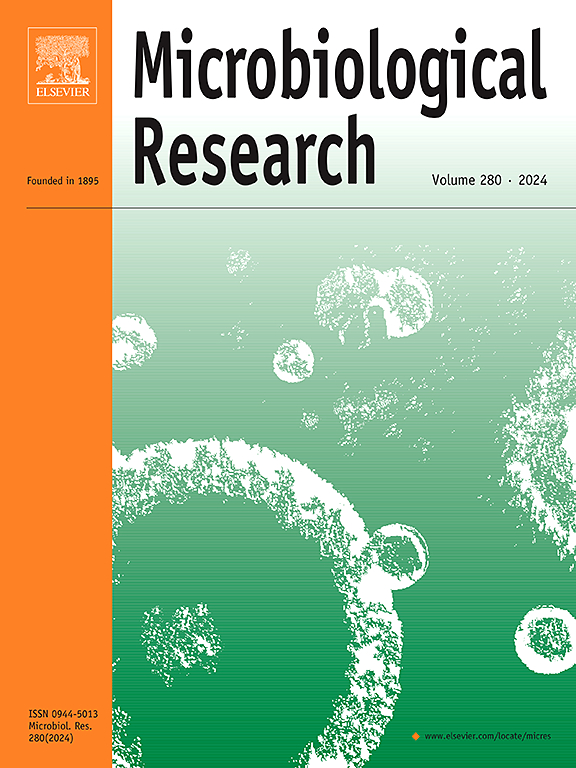基因组学和代谢组学的见解,细菌菌株的作用模式控制葡萄藤木材病原体,地中海Fomitiporia
IF 6.1
1区 生物学
Q1 MICROBIOLOGY
引用次数: 0
摘要
葡萄主干病害(GTDs),特别是Esca,是全球葡萄栽培面临的主要挑战,导致巨大的经济损失。由于没有有效的防治方法,开发生物防治等新方法对于管理gtd至关重要。我们的目的是选择对白腐真菌病原体地中海Fomitiporia mediterranea (Fmed)有效的生物防治细菌,并研究它们的作用机制。对58株细菌进行了体外逐步筛选,以评估它们通过产生挥发性和扩散性代谢物来抑制Fmed生长的能力。对7个葡萄品种的木屑进行了筛选。在58个测试菌株中,49个通过其挥发性有机化合物抑制Fmed生长超过50% %,只有8个通过其琼脂扩散代谢物实现这一目标。乳酸假单胞菌SV9、副蜱假单胞菌S45和多粘类芽孢杆菌SV13对木屑的Fmed有较强的抑制作用,且具有品种依赖性。我们选择这些菌株进行全基因组分析和代谢组学分析,通过LC-MS/MS分析扩散化合物,SPME GC-MS分析挥发性化合物。P. polymyxa SV13主要通过弥散代谢物抑制Fmed,主要产生镰刀菌素型化合物。相反,假单胞菌主要通过其挥发性代谢物起作用,主要产生抗真菌化合物二甲基二硫化物。对这三种菌株的基因组分析揭示了调控生物防治剂(bca)直接和间接机制的基因簇。我们的研究结果强调了综合研究的重要性,这些研究结合了模拟野外条件的体外实验,并详细研究了提高bcaa疗效的作用模式。本文章由计算机程序翻译,如有差异,请以英文原文为准。
Genomic and metabolomic insights into the modes-of-action of bacterial strains to control the grapevine wood pathogen, Fomitiporia mediterranea
Grapevine trunk diseases (GTDs), particularly Esca, represent a major challenge for viticulture worldwide, leading to substantial economic losses. With no effective control treatments available, developing new methods such as biocontrol is crucial for managing GTDs. Our aim was to select biocontrol bacteria effective against the white-rot fungal pathogen Fomitiporia mediterranea (Fmed) and to investigate their mechanisms of action. A stepwise screening of 58 bacterial strains was conducted in vitro to assess their ability to inhibit Fmed growth through volatile and diffusible metabolites production. The screening was also done on wood sawdust from seven different grapevine cultivars. Out of 58 tested strains, 49 inhibited Fmed growth by over 50 % through their volatile organic compounds, only eight achieving this through their agar-diffusible metabolites. Pseudomonas lactis SV9, Pseudomonas paracarnis S45, and Paenibacillus polymyxa SV13 exhibited a strong efficacy in inhibiting Fmed on wood sawdust in a cultivar-dependent manner. We selected these strains for whole genome analysis and metabolomic profiling via LC-MS/MS for diffusible compounds and SPME GC-MS for volatile compounds. P. polymyxa SV13 inhibited Fmed primarily through diffusible metabolites, producing mainly fusaricidin-type compounds. Conversely, Pseudomonas strains acted mainly via their volatile metabolites, producing mainly the antifungal compound dimethyl disulfide. Genome analysis of the three bacterial strains revealed gene clusters responsible for regulating both direct and indirect mechanisms in biocontrol agents (BCAs). Our findings highlight the importance of comprehensive studies that combine in vitro experiments mimicking field conditions, with detailed investigations into modes of action to improve BCAs efficacy.
求助全文
通过发布文献求助,成功后即可免费获取论文全文。
去求助
来源期刊

Microbiological research
生物-微生物学
CiteScore
10.90
自引率
6.00%
发文量
249
审稿时长
29 days
期刊介绍:
Microbiological Research is devoted to publishing reports on prokaryotic and eukaryotic microorganisms such as yeasts, fungi, bacteria, archaea, and protozoa. Research on interactions between pathogenic microorganisms and their environment or hosts are also covered.
 求助内容:
求助内容: 应助结果提醒方式:
应助结果提醒方式:


